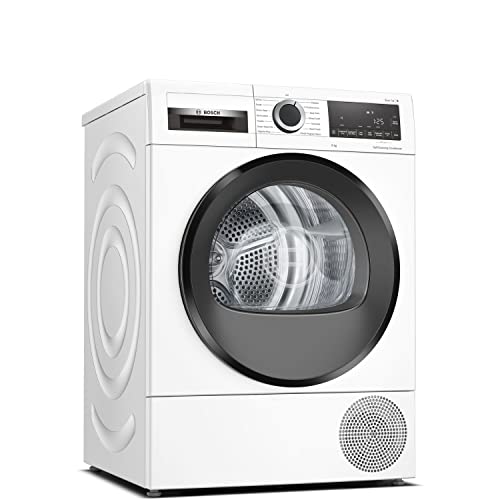Why You'll Want To Read More About Dryers Heat Pump
페이지 정보

본문
Heat Pump Tumble Dryers
 Heat pump tumble dryers recycle the hot air that they use to dry your clothes instead of venting it out. This is a cost-effective option for your household as it saves energy.
Heat pump tumble dryers recycle the hot air that they use to dry your clothes instead of venting it out. This is a cost-effective option for your household as it saves energy.
John Lewis has a range of tumble dryers, which include both vented and condenser models, as well as heat pump tumble dryers. Learn more about the options in our guide to tumble dryers.
Cost
Tumble Dryers heat Pump are fantastic for eliminating the need to hang laundry in the sun and to save space for storage, but they are prone to using much energy. When looking to reduce your energy costs it might be worth trying an energy-efficient tumble dryer. They're more expensive at first, but they will save you money over time because of their lower energy consumption.
The heat pump tumble dryers function by heating the air that was already warmed up during the drying process, which results in significantly lower energy bills than vented or condenser models. This type of tumble dryer typically uses approximately half the electricity as a vented or condenser model, and as such can save you as much as PS173 per year on your utility bills.
When it comes to comparing the cost of a heat pump tumble dryer versus other types, the difference is usually minimal. It is essential to think about the amount of energy required and how frequently you will use your tumble dryer. You'll need to factor in the wattage of your machine as well as your electricity tariff, which will influence the price you pay for each tumble dry.
Vented tumble dryers use gas to dry the laundry and are powered by mains gas and are therefore a more expensive option for those on a tight budget. The options for installation are restricted because they have to be installed in a space with adequate ventilation for the humid air.
Condenser dryers eliminate moisture from the laundry by moving hot air into a separate condensing unit, where it's converted to water. This water is then drained away, either into a removable container which needs to be emptied manually or be plugged into your drainage system for continuous removal. This gives you more flexibility in the installation locations, but you will need to be prepared for any additional maintenance by ensuring that the drain pipe is in good condition.
Energy efficiency
A tumble dryer heat-pump can help you save money on energy costs. The technology uses less electricity to heat the air inside the tumble dryer. This lets it dry clothes more efficiently and at lower temperatures than vented models.
They also use a coolant that liquifies the humidity in the air and ejects it through the condenser. This means they use less power to run than traditional vented models. The dryers may take a little longer to finish your laundry cycle compared to vented models, Dryers heat Pump however the clothes will appear and feel better for longer due to the lower temperatures.
Typically they'll cost between $500 to $700 more upfront than condenser dryers but the extra cost is offset by the savings you'll earn on your energy bills over the long term. They are also more expensive and require adequate ventilation.
Like all electrical appliances, it's essential that any tumble dryer installation is done by a Gas Safe engineer. A vented dryer requires a long, flexible vent hose that is permanently connected to the appliance at one end and a drainage point at the other - the drain, window or door. This hose cannot be shared or used in a manner that could damage it.
Like heat pump dryers, a condenser operates by heating the air by using an electrical element and then expels the moisture via a tray for condensation. They are typically heavy-duty performers with larger capacities for wet loads that range between 6 and 10kg. They also are quieter to operate. They're more expensive to purchase than tumble dryers that use heat pumps and they can't be installed without an ongoing wall connection. The cost of running them is also higher than heat pump dryers, as they have to generate more heat to evaporate the moisture in your laundry. They are less efficient than vented models. They still require electricity to turn the motor which rotates your clothes.
Noise
Tumble dryers produce plenty of noise however, the volume they emit is dependent on a variety of factors. The decibel rating is just one of them, and the frequency of the noise will also affect how loud it is. The sound may be amplified by nearby resonant objects such as work surfaces, cabinets or furniture, and may be affected by the room's acoustics. The sound produced by your tumble dryer could be obstructed by carpets or other acoustic absorbent material.
Condenser and heat pump tumble dryers are quieter than vented models, however it's worth bearing in mind that they're still loud. They are gentler on your fabrics, and dry your laundry less quickly due to lower air temperatures and a much longer cycle than traditional models. They are less damaging to clothes and less likely to cause color loss that is typically associated with tumble dryers of the past that make use of high temperatures.
If you're planning to use your tumble dryer mostly together with a washing machine it's important to keep in mind that the two appliances must be located close to each other to prevent the noise and vibrations that occur when they are in use. To avoid this issue, a washer and dryer stacking set is available for both kinds of appliances.
They require an ongoing flow of air to perform, and therefore must be located in a location that is well ventilated in your home. You'll need to ensure that the vent hose is connected to the appliance and securely routed outside of your house, rather than directed through a window or door.
The condenser tumbler, on the other hand does not require the permanent connection to a vent and can be placed anywhere in your home. It stores the vapour and any water left in containers that can be manually empty, or connected to a drain using the drainage pipe, which will automatically empty it.
It is possible to convert an unventilated tumble dryer into a condenser model by using the conversion kit, but it will void the manufacturer's warranty and should only be done by a trained professional. These kits come with the parts to install vents, aswell as a small pump to eliminate condensation.
Maintenance
A tumble dryer with a heat pump differs from vented or condenser models as it doesn't require venting externally to draw out the hot air. The warm air that is blown over your clothes is collected and then pumped through a condenser, which is used to separate the heated water from the air. It is then collected in a water reservoir (sometimes called a tank) inside the appliance. You'll need to empty the tank eventually however, dryers heat pump you can keep the dryer in the same space as if you have vents.
Compared to vented models, the heat pump model uses around 50 percent less energy. This makes it cheaper to run, saving you around PS42-PS51 per year according to Which? and is also better for the environment. It's an inexpensive tumbler to purchase and you need to make sure you can afford the upfront costs.
A tumbler with a heat pump requires minimal maintenance, other than cleaning the lint filters and checking for any fluff on the heater unit once in a while. You will need to clean your condensation drain more often and it takes longer to dry your clothes than vented dryers.
If you're looking for a low-cost tumble dryer, it might be worth looking into a sensor model that automatically stops when the laundry is done. This will prevent over-drying that can damage your clothes. You will need to program the drying cycle of your dryer if you have a lot of different clothes.
Brands like Beko and John Lewis offer tumble dryers that make use of condenser, heat pump, or vented technology. John Lewis offers a free home delivery and a two-year guarantee. Always check the warranty details thoroughly before purchasing an appliance, especially one that is electrical like a tumble dryer, to make sure you're covered in case of breakdowns or faults.
 Heat pump tumble dryers recycle the hot air that they use to dry your clothes instead of venting it out. This is a cost-effective option for your household as it saves energy.
Heat pump tumble dryers recycle the hot air that they use to dry your clothes instead of venting it out. This is a cost-effective option for your household as it saves energy.John Lewis has a range of tumble dryers, which include both vented and condenser models, as well as heat pump tumble dryers. Learn more about the options in our guide to tumble dryers.
Cost
Tumble Dryers heat Pump are fantastic for eliminating the need to hang laundry in the sun and to save space for storage, but they are prone to using much energy. When looking to reduce your energy costs it might be worth trying an energy-efficient tumble dryer. They're more expensive at first, but they will save you money over time because of their lower energy consumption.
The heat pump tumble dryers function by heating the air that was already warmed up during the drying process, which results in significantly lower energy bills than vented or condenser models. This type of tumble dryer typically uses approximately half the electricity as a vented or condenser model, and as such can save you as much as PS173 per year on your utility bills.
When it comes to comparing the cost of a heat pump tumble dryer versus other types, the difference is usually minimal. It is essential to think about the amount of energy required and how frequently you will use your tumble dryer. You'll need to factor in the wattage of your machine as well as your electricity tariff, which will influence the price you pay for each tumble dry.
Vented tumble dryers use gas to dry the laundry and are powered by mains gas and are therefore a more expensive option for those on a tight budget. The options for installation are restricted because they have to be installed in a space with adequate ventilation for the humid air.
Condenser dryers eliminate moisture from the laundry by moving hot air into a separate condensing unit, where it's converted to water. This water is then drained away, either into a removable container which needs to be emptied manually or be plugged into your drainage system for continuous removal. This gives you more flexibility in the installation locations, but you will need to be prepared for any additional maintenance by ensuring that the drain pipe is in good condition.
Energy efficiency
A tumble dryer heat-pump can help you save money on energy costs. The technology uses less electricity to heat the air inside the tumble dryer. This lets it dry clothes more efficiently and at lower temperatures than vented models.
They also use a coolant that liquifies the humidity in the air and ejects it through the condenser. This means they use less power to run than traditional vented models. The dryers may take a little longer to finish your laundry cycle compared to vented models, Dryers heat Pump however the clothes will appear and feel better for longer due to the lower temperatures.
Typically they'll cost between $500 to $700 more upfront than condenser dryers but the extra cost is offset by the savings you'll earn on your energy bills over the long term. They are also more expensive and require adequate ventilation.
Like all electrical appliances, it's essential that any tumble dryer installation is done by a Gas Safe engineer. A vented dryer requires a long, flexible vent hose that is permanently connected to the appliance at one end and a drainage point at the other - the drain, window or door. This hose cannot be shared or used in a manner that could damage it.
Like heat pump dryers, a condenser operates by heating the air by using an electrical element and then expels the moisture via a tray for condensation. They are typically heavy-duty performers with larger capacities for wet loads that range between 6 and 10kg. They also are quieter to operate. They're more expensive to purchase than tumble dryers that use heat pumps and they can't be installed without an ongoing wall connection. The cost of running them is also higher than heat pump dryers, as they have to generate more heat to evaporate the moisture in your laundry. They are less efficient than vented models. They still require electricity to turn the motor which rotates your clothes.
Noise
Tumble dryers produce plenty of noise however, the volume they emit is dependent on a variety of factors. The decibel rating is just one of them, and the frequency of the noise will also affect how loud it is. The sound may be amplified by nearby resonant objects such as work surfaces, cabinets or furniture, and may be affected by the room's acoustics. The sound produced by your tumble dryer could be obstructed by carpets or other acoustic absorbent material.
Condenser and heat pump tumble dryers are quieter than vented models, however it's worth bearing in mind that they're still loud. They are gentler on your fabrics, and dry your laundry less quickly due to lower air temperatures and a much longer cycle than traditional models. They are less damaging to clothes and less likely to cause color loss that is typically associated with tumble dryers of the past that make use of high temperatures.
If you're planning to use your tumble dryer mostly together with a washing machine it's important to keep in mind that the two appliances must be located close to each other to prevent the noise and vibrations that occur when they are in use. To avoid this issue, a washer and dryer stacking set is available for both kinds of appliances.
They require an ongoing flow of air to perform, and therefore must be located in a location that is well ventilated in your home. You'll need to ensure that the vent hose is connected to the appliance and securely routed outside of your house, rather than directed through a window or door.
The condenser tumbler, on the other hand does not require the permanent connection to a vent and can be placed anywhere in your home. It stores the vapour and any water left in containers that can be manually empty, or connected to a drain using the drainage pipe, which will automatically empty it.
It is possible to convert an unventilated tumble dryer into a condenser model by using the conversion kit, but it will void the manufacturer's warranty and should only be done by a trained professional. These kits come with the parts to install vents, aswell as a small pump to eliminate condensation.
Maintenance
A tumble dryer with a heat pump differs from vented or condenser models as it doesn't require venting externally to draw out the hot air. The warm air that is blown over your clothes is collected and then pumped through a condenser, which is used to separate the heated water from the air. It is then collected in a water reservoir (sometimes called a tank) inside the appliance. You'll need to empty the tank eventually however, dryers heat pump you can keep the dryer in the same space as if you have vents.
Compared to vented models, the heat pump model uses around 50 percent less energy. This makes it cheaper to run, saving you around PS42-PS51 per year according to Which? and is also better for the environment. It's an inexpensive tumbler to purchase and you need to make sure you can afford the upfront costs.
A tumbler with a heat pump requires minimal maintenance, other than cleaning the lint filters and checking for any fluff on the heater unit once in a while. You will need to clean your condensation drain more often and it takes longer to dry your clothes than vented dryers.
If you're looking for a low-cost tumble dryer, it might be worth looking into a sensor model that automatically stops when the laundry is done. This will prevent over-drying that can damage your clothes. You will need to program the drying cycle of your dryer if you have a lot of different clothes.
Brands like Beko and John Lewis offer tumble dryers that make use of condenser, heat pump, or vented technology. John Lewis offers a free home delivery and a two-year guarantee. Always check the warranty details thoroughly before purchasing an appliance, especially one that is electrical like a tumble dryer, to make sure you're covered in case of breakdowns or faults.
- 이전글Where Will Double Glazing In Leeds Be 1 Year From In The Near Future? 24.04.27
- 다음글Mesothelioma Claim Techniques To Simplify Your Everyday Lifethe Only Mesothelioma Claim Technique Every Person Needs To Learn 24.04.27
댓글목록
등록된 댓글이 없습니다.








